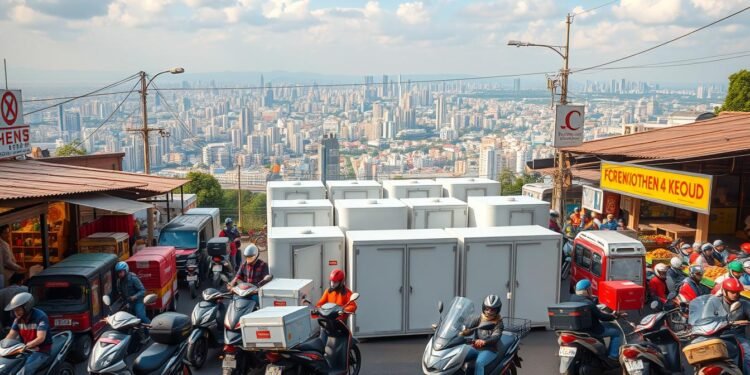Did you know the food delivery industry is transforming faster than ever? The rise of cloud kitchens is reshaping how we eat, with the sector now valued at $73.18 billion in 2024. Experts predict it will nearly double by 2030, reaching $141.08 billion.
Asia Pacific leads the charge, holding nearly half of global revenue. Emerging regions like the Middle East and Africa are also gaining traction. The pandemic unexpectedly boosted demand, proving that convenience is here to stay.
With an 11.9% annual growth rate, this sector offers huge opportunities. Whether you’re an investor or a food enthusiast, understanding these trends is key to staying ahead.
Key Takeaways
- The global market is projected to hit $141.08 billion by 2030.
- Asia Pacific dominates with a 47.8% revenue share.
- An 11.9% annual growth rate highlights strong expansion.
- COVID-19 accelerated demand for delivery services.
- New markets in the Middle East and Africa show promise.
Introduction to the Cloud Kitchen Market
The way we order meals has undergone a radical shift in recent years. Food delivery services now rely on invisible hubs where meals are prepped exclusively for online orders. These spaces, often called ghost kitchens, eliminate dining areas to focus solely on efficiency.
Most operations use a hub-and-spoke model. A central kitchen handles bulk prep while smaller satellites fulfill local orders. This cuts costs by 30% compared to traditional restaurants needing prime real estate.
Quick-service chains face new challenges. Rising rents and labor costs make online food delivery models more appealing. Independent brands hold 62.1% of revenue by offering niche menus through apps.
The pandemic accelerated adoption. Lockdowns proved consumers prioritize convenience. U.S. orders surged 135% in 2020, with projections hitting $27.47 billion by 2032.
Dual-income households drive demand. With less time to cook, busy families increasingly rely on app-based meals. India’s sector grows at 14.6% annually as urban lifestyles evolve.
Global Cloud Kitchen Market Size and Projections
Behind every app-based meal lies a rapidly evolving business model. The sector’s valuation shows slight variations across reports, with 2024 estimates between $70.18B and $73.18B. Weighted averages suggest $71.68B reflects current realities best.
2024 Market Valuation and Key Metrics
Discrepancies stem from regional reporting differences and kitchen pod adoption rates. Shared spaces now account for 38% of operations, reducing overhead costs. Inflationary pressures add uncertainty, but demand remains resilient.
2030 Growth Forecast and CAGR Analysis
Projections for 2030 range from $141.08B (11.9% CAGR) to $144.71B (9.47% CAGR). The Middle East and Africa lead growth at 11.9%, fueled by expanding delivery platforms.
Regional trajectories vary widely. Asia’s dominance continues, but Europe’s stricter regulations slow expansion. North America balances saturation with tech-driven efficiency gains.
Key Drivers of Cloud Kitchen Market Growth
The explosive growth of app-based meal services isn’t accidental—it’s driven by powerful forces. From tech breakthroughs to shifting lifestyles, these factors ensure the sector’s momentum won’t slow soon.
Rise of Food Delivery Platforms
Food delivery platforms like DoorDash and Uber Eats now drive 32% of sector efficiency. Their partnerships cut costs through shared services, while dynamic commission models (15–30% per order) incentivize high-volume operations.
Metro areas adopt these platforms 3x faster than rural zones. Urban centers benefit from dense delivery networks, slashing wait times to under 30 minutes.
Urbanization and Changing Consumer Lifestyles
68% of city dwellers order meals more than three times weekly. Dual-income households prioritize convenience, with 54% citing “no time to cook” as their top reason for using food delivery platforms.
ZOIL’s oil-free cooking tech caters to health-conscious consumer demands. Menus now emphasize nutrition without sacrificing speed—a key differentiator in crowded markets.
Technological Advancements in Logistics
AI-powered routing slashes delivery times by 18%. IoT sensors in kitchens monitor equipment, reducing downtime by 22%. These technology leaps enable dark stores—dedicated fulfillment hubs—to operate with 40% fewer staff.
Real-time tracking and automated dispatch systems ensure seamless services, making scalability easier for brands.
Cloud Kitchen Market Segmentation
Not all food ventures operate the same way—structure defines success. The sector splits into distinct types and operational models, each catering to different business needs. Understanding these segments helps brands optimize costs and scalability.
Independent vs. Commissary/Shared Kitchens
Independent setups dominate with 62.1% of revenue in 2024. Brands like Smoor thrive by controlling their entire business chain, from prep to delivery. This model suits niche menus but requires higher upfront investment.
Commissary spaces, like CloudKitchens, offer 19% higher growth potential. Shared infrastructure cuts overhead, ideal for startups testing concepts. Rebel Foods uses hybrid types, blending independence with shared tech hubs.
Franchised vs. Standalone Models
Franchised brands will hit $27.37B by 2025, leveraging established names. DoorDash’s virtual brands exemplify this, scaling without physical stores. Standalone ventures, however, adapt faster to local tastes but face steeper marketing costs.
Regulations vary by segment. Franchises navigate stricter rules, while independents innovate freely. The right type balances risk and reward—no one-size-fits-all solution exists.
Regional Market Insights
Regional dynamics shape the future of food delivery in surprising ways. From tech-savvy megacities to emerging economies, adoption rates reveal stark contrasts. Understanding these differences helps brands tailor strategies for local consumers.
Asia Pacific Dominance
Asia Pacific commands 47.8% market share, fueled by dense urban populations. China leads with $2.3B invested in modular kitchen pods last year. Platforms like Swiggy and Zomato saturate India, processing 1.5M daily orders.
GrabFood’s Southeast Asia expansion highlights untapped potential. The region’s mobile-first culture makes it ideal for delivery-only models.
North America’s Rapid Adoption
North America grows faster than Europe, with NYC health permits up 41%. California’s strict labor laws contrast with Texas’s business-friendly rules. This region thrives on hybrid models—70% of virtual brands here also operate physical stores.
Tech hubs like Austin and Denver see the highest demand. Consumers favor eco-friendly packaging and diverse menus.
Middle East & Africa: Emerging Growth Hotspot
Dubai’s market share jumped 22% last year, with halal-focused clusters expanding. Solar-powered hubs in Nigeria cut energy costs by 60%. The demand for localized flavors drives innovation.
South Africa’s delivery apps grew 18% in 2023. This region proves adaptability is key to winning new consumers.
Leading Cloud Kitchen Companies
Innovative companies are rewriting the rules of food service with virtual-first strategies. From shared infrastructure to AI-driven logistics, these players dominate the $70B+ sector by optimizing every step of the delivery chain.
Profiles of Top Players
DoorDash leads with its virtual brand incubator, launching 20+ concepts like The Burgery from a single hub. Their data-driven menus cut R&D costs by 40%, appealing to investors eyeing scalable operations.
Rebel Foods, valued at $1.3B, pivoted from online-only to hybrid brands like Ovenstory Pizza. Their offline kiosks boosted margins by 22%, proving physical touchpoints still matter.
Dubai’s Kitopi expanded across the MEANA region after acquiring Finnest for $160M. Their centralized tech platform streamlines services for 200+ partner restaurants, reducing kitchen downtime by 30%.
Recent Investments and Industry Moves
The Curefoods-Maverix merger created India’s largest network, serving 15K daily orders. Private equity firms now target companies with asset-light models, fueling a 17% YoY rise in sector funding.
IPO rumors swirl around Rebel and Kitopi as they replicate Sweetgreen’s success. Meanwhile, DoorDash’s Kitchen Hub program attracts chefs testing niche brands without upfront costs—a game-changer for culinary startups.
Emerging Trends in Cloud Kitchens
Tomorrow’s meals are being designed by algorithms and prepared by robots. The industry is evolving beyond basic delivery models to incorporate cutting-edge technology and health-conscious innovations. From AI-created recipes to carbon-neutral operations, these advancements redefine convenience.
Health-Conscious Menu Innovations
ZOIL’s oil-free Indian cuisine proves consumer demand for healthier options keeps growing. Their model uses advanced cooking techniques to cut calories without sacrificing flavor. Allergen-free concepts now account for 19% of new virtual brands.
Nutritional analysis tools help kitchens tailor meals to dietary needs. Apps display real-time data about ingredients and cooking methods. This transparency builds trust with health-focused customers.
AI and Automation in Food Preparation
Avane’s AI-created SoUp! brand generates recipes based on trending flavors. Their system processes millions of reviews to predict the next viral dish. Nearly 37% of operations now use predictive analytics for inventory management.
Robotic fry stations maintain perfect oil temperatures while reducing waste. Voice-AI systems take orders and adjust recipes for allergies automatically. These technology upgrades slash labor costs by up to 40%.
The industry is testing blockchain-based loyalty programs and NFT memberships. Carbon-neutral delivery fleets complete the eco-friendly transformation. Every innovation targets the modern consumer‘s values—convenience meets conscience.
Challenges and Restraints
Rapid expansion brings growing pains for digital-first food operations. While the industry shows impressive growth, operators face mounting pressures from established players and complex regulations. These hurdles could slow momentum if not addressed strategically.
Competition from Quick-Service Restaurants
Traditional restaurants are fighting back with upgraded digital infrastructure. McDonald’s China reported 14% sales cannibalization when nearby ghost kitchens launched similar menus. Their advantages include:
– Brand recognition that new operators lack
– Existing customer loyalty programs
– Lower customer acquisition costs
Third-party delivery dependence creates another vulnerability. 29% of operators complain about steep platform fees cutting into profits. This makes standalone concepts particularly risky in oversaturated markets.
Regulatory and Operational Hurdles
Compliance costs vary wildly by region. The EU’s Virtual Kitchen Safety Act added $18,000 annually per location for some operators. Common pain points include:
– Insurance gaps for shared workspaces
– Packaging sustainability requirements
– High labor turnover (avg. 42% yearly)
These factors strain profit margins, especially for smaller players. The industry must standardize practices while maintaining the flexibility that fueled its growth. Solutions like automated compliance tracking show promise for reducing these burdens.
Success requires balancing demand for convenience with sustainable service models. Those who solve these challenges will lead the next phase of evolution.
Future Outlook for the Cloud Kitchen Industry
The next decade will redefine how meals reach our tables through innovation and expansion. Current forecasts suggest the sector could nearly double in value, reaching $154B by 2030. This growth period will be shaped by tech adoption and emerging regional opportunities.
Three key drivers will dominate this evolution. Satellite kitchen networks will expand delivery reach, while drone trials test last-mile solutions. Meanwhile, VR training systems could reduce staff onboarding time by 40%.
Legislation will play a crucial role. Franchising laws are adapting to virtual brands, and waste-to-energy initiatives gain traction. These developments create a roadmap for sustainable scaling.
Projected Expansion Through 2030
The $141B-$154B valuation range reflects varying adoption rates across regions. SaaS tools for operations management show particular promise, with a 12% annual growth rate expected. This software segment could hit $8.2B by the forecast period’s end.
Recent research highlights unexpected opportunities. Modular kitchen pods enable rapid deployment in underserved areas. These units can be operational within 72 hours, addressing sudden demand surges.
Untapped Regional Potential
Africa’s urban centers represent a 38% untapped market, with Lagos and Nairobi leading adoption. Localized menus and mobile payment integration are key to winning these consumers. Solar-powered hubs already show 60% cost savings in trial cities.
Regulatory frameworks are evolving to support this expansion. Ghana recently streamlined permits for shared spaces, cutting approval times from 90 to 14 days. Such changes accelerate market entry during this critical period.
Ongoing research into drone corridors could solve infrastructure challenges. Pilot programs in Rwanda demonstrate how aerial routes bypass road congestion. These innovations make remote areas viable for the first time.
Conclusion
The cloud kitchen sector shows no signs of slowing, with Asia’s dominance and Africa’s rapid adoption shaping its future. Tech-driven efficiency keeps pushing the industry forward, from AI menus to automated prep stations.
Yet risks remain. Oversaturated urban areas face stiff competition, while rural zones struggle with infrastructure. Investors eye shared kitchen models as safer bets, balancing scalability with lower overhead.
These digital-first spaces are becoming the delivery backbone of modern food culture. They blend convenience with innovation, creating a new dining era—one where your favorite meal arrives faster than ever.
FAQ
What is driving the growth of cloud kitchens globally?
The surge in online food delivery services, urbanization, and evolving consumer dining preferences are major growth drivers. Platforms like DoorDash and Uber Eats have accelerated demand for efficient food production models.
Which region holds the largest share in the cloud kitchen industry?
Asia Pacific dominates with a 47.8% revenue share, fueled by dense urban populations and tech-savvy consumers. North America follows closely due to rapid adoption of delivery platforms.
How are cloud kitchens segmented by type?
They are categorized into independent kitchens (single-brand operations) and commissary/shared kitchens (multi-brand hubs). Franchised and standalone models further define their operational nature.
What role does technology play in cloud kitchen operations?
AI-driven logistics, automation in food prep, and data analytics optimize efficiency. Companies like Kitopi use smart tech to manage multiple brands from a single location.
What challenges do cloud kitchens face?
High competition from quick-service restaurants (QSRs) and regulatory hurdles, like zoning laws, pose challenges. Maintaining quality while scaling operations is another key restraint.
Which companies lead the cloud kitchen market?
Major players include Rebel Foods, DoorDash (via its ghost kitchen arm), and Kitopi. Recent mergers, like Reef Technology’s expansions, highlight aggressive industry growth.
What trends are shaping the future of cloud kitchens?
Health-focused menus, hyper-localized branding, and AI integration are rising trends. Automation is reducing costs, while customization meets niche consumer demands.
What is the projected CAGR for the cloud kitchen market?
Analysts forecast a robust 12.3% CAGR from 2024 to 2030, with the market value expected to exceed 2 billion by 2030, driven by untapped regional opportunities.






